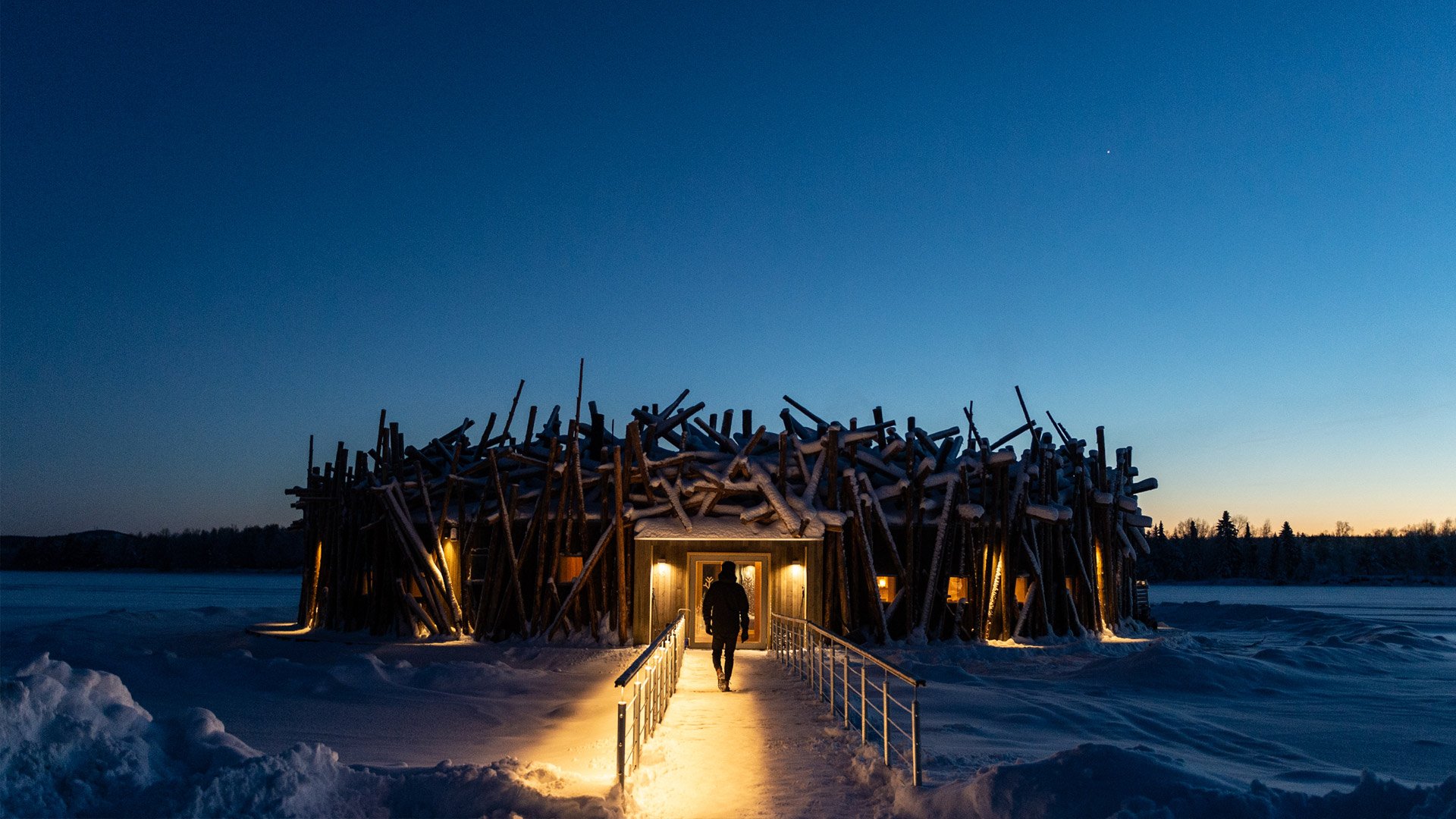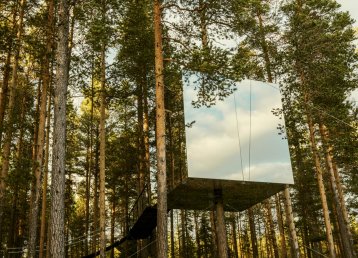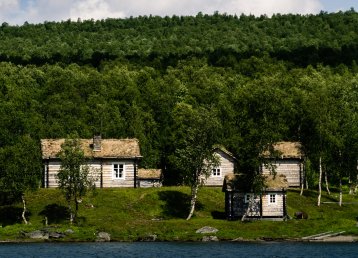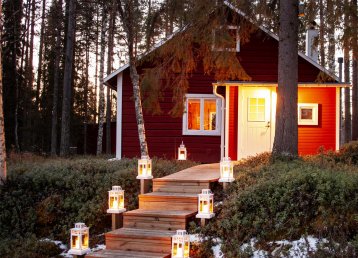Bertil Harström, a fly fisherman and architect, has already turned 70. This afternoon he takes a stroll outside Arctic Bath, a cold bath-house on the Lule River outside Harads. The concept was born almost ten years ago, at the after-party of the inauguration of the newly opened Treehotel. Someone patted Bertil on his shoulder and said: “Now you have to design a sauna raft for the river, so people staying at the hotel have something to do”.
— So, this is basically an after-party that went overboard, he says and laughs.
— At the time I didn’t really think a sauna raft would be my next project and I didn’t do anything about it. Ten years passed, but that’s when the idea about the river got firmly lodged in my head.
The ‘sauna raft’, Arctic Bath, become a 700 square-metre cold bathhouse and hotel. Shape and design are inspired by the image of an old-fashioned log jam, and the resulting creation is Sweden’s perhaps coolest new hotel project.
Hotel in the trees
By now, most of you are familiar with the story about Treehotel. About a group of architects on a fishing trip with Kent Lindvall, and how they started talking about the film ‘The Tree Lover’, by the now-deceased documentary filmmaker Jonas Selberg Augustsén, around the campfire one evening. The film had just been shown on Swedish TV and brought to life a childhood dream of building tree houses. The project around Treehotel brings together some of the most recognised architects and designers in Scandinavia. Tomas Sandell, Tham&Videgård, Cyren&Cyren, Sami Rintala, Snøhetta, Bjarke Ingels and Bertil Harström – they have all built a treehouse each, now rented out as hotel rooms.
Bertil is the only one who has two treehouses at Treehotel. One looks like the most common house in a forest: a bird’s nest. The other one is its opposite, the most unexpected thing you could come across in a forest: a UFO. Bertil has also designed the public facilities at Treehotel, such as sauna, relax and spa. He has an unfaltering love of wood.
— Yes, damn it. I don’t think there’s anything sadder than the image of trucks driving timber down to the coast.
— Beautiful trees exported at the going dollar exchange rate. It’s so unimaginative.
The story of Treehotel
Starting out as a dream of something new, getting mapped out around a campfire on a fishing trip, the Treehotel in Harads really is a story of its own. And some great architecture among the treetops.
Wooden constructions
For more than 30 years, Bertil Harström has been fighting for people’s right to build wooden houses. His love of tree houses and log jams sits deep inside his soul. He is an architect and designer, but deep down, he is more of an idealist and tree hugger. These projects are not just an architect’s vision and dreams, they are based on a belief that in Sweden, we actually miss something when we do not allow ourselves to build more using wood.
— You know, wood is a brilliant building material. It absorbs moisture, binds carbon dioxide, transports heat, but still, every Swede has to enclose his house in plastic to get building permits or a mortgage. It’s sick.
So it is Bertil who designed the very origin of Arctic Bath, He got the idea of a cold bath house in the form of a log cabin early on and together with the towering Johan Kauppi he was able to design the new floating design hotel in Harads. In addition, interior architect Annkathrin Lundqvist has designed the six houses that stand on land.
The story of Arctic Bath
A cold bath on the river Luleälven. Designed like a log jam, the conceptual architecture of a monument of bygones, Arctic Bath in Harads never ceases to inspire guests to have a dip in the cold.
The eco lodge
Mikael Vinka is sat at the rough-hewn dining table in the dining room at Geunja, the Sámi Eco Lodge he built by hand 20 years ago. He remembers the effort.
— It was damn hard work. Yes, that’s probably all it was.
Those days, eco-things were not in fashion, like they are now. The mountain world where Geunja is located belongs to Sorsele municipality. It became an eco-municipality already back in 1989, one of the first two in Sweden, but even so, saying that it was something of a movement back then would be an exaggeration. Mikael and Anki Vinka’s idea, however, was to build Geunja and make it something extra special. The location was an old residence at Tjulån, in the Ammarnäs mountains. There was a spring on the site: a prerequisite for good water in summer and winter.
— Mainly, it gave you a feeling of being welcomed on the spot. That’s the most important thing when you look for somewhere to live that you want to be there.
Mikael has hand-hewed the logs, insulated them with moss and used peat and birch bark as roofing. Everything was done the way it was when the first nomadic Sámi became settlers, part of the Sámi tradition that is sometimes forgotten.
— You know, even the nails are old hand-forged nails. If carrying the stone for the fireplace was a struggle, that was probably nothing compared to the frustration of trying to hammer in hand-forged nails.
— You quickly learn to hit them straight, he says and laughs.
Today, Geunja welcomes twelve guests about twelve times per year. They do everything to make sure the place does not get worn out, and for us to feel welcome.
Geunja, a sámi eco lodge
In the highlands of Swedish Lapland, Mikael and Anki Vinka live the old way of life, as a homage to the people who have roamed this place for thousands of years. Some claims Geunja is one of the best-kept secrets of Swedish Lapland, not least the fortunate ones who have gotten a humbling glimpse of the everyday life here.
The mountain villa
In Riksgränsen, a bit further north in the mountain world, there is Niehku Mountain Villa. A hotel dream as far north and as far away from the rest of Sweden as you can get, more or less. At a UNESCO gala in Paris, Niehku won the prestigious Prix Versailles for the best hotel interior in the world. Stylt Trampoli, responsible for the design, has succeeded in capturing the uniqueness of the history of Riksgränsen – the Ore Railway – and it breathes new life into the building. The stone wall of the old train depots runs straight through the hotel building and in the restaurant the grease pit for the steam trains of the time has become the perfect wine cellar.
Niehku, which is the Northern Sami word for dream, came about thanks to the passion of two friends who both came to Riksgränsen in the 1990s. Skiing young people, with a greater longing for snow than school, where the mountain and Riksgränsen’s old historic hotel became a refuge. Little did they know then that Riksgränsen would become a landmark in life, that Niehku could become more than just a dream, but also a hotel for style-conscious skiers and travelers from all corners of the world.
A backcountry skier’s dream of a design hotel
Niehku Mountain Villa is a stunning design hotel and a hideaway in Riksgränsen, Swedish Lapland. In an Arctic environment, this design hotel and mountain vista stand out as a pilgrimage for travelers searching for heli-skiing, good food, hikes, and a great time.
The original Icehotel
Design and/or boutique hotels, let us call them lifestyle hotels, is nothing new. They started to emerge already in the 1980s, and perhaps Icehotel in Jukkasjärvi could be called the first in Swedish Lapland. This 2019/2020 season, Icehotel celebrates its 30th anniversary, and as always, design and the work of artists have been a priority.
If mentioning five key points for a hotel to be referred to as a lifestyle hotel, the first thing to remember is your Shakespeare. “All the world’s a stage, and all the men and women merely players”. Icehotel has been offering today’s bucket-list travellers a stage for almost three decades. That desire to blur the boundaries between outside and inside is something Icehotel always succeeds in.
More than anyone else, it was the Americans Ian Schrager and Steve Rubell who set the criteria for what a lifestyle hotel is. They are the founders of the legendary club Studio 54 in New York, and the creators of the hotel The Morgans. According to them, a lifestyle hotel should indeed be a theatre stage with the lobby as its centre. The hotel should reflect the lifestyle of its guests and blur the boundaries between outside and inside. Preferably, the hotel itself should be the main reason why someone would visit the location at all. The hotel should be a destination in itself.
The original Icehotel and how it went down
In the late 1970s, Yngve Bergqvist moved up north to Kiruna, Swedish Lapland, because he wanted to prolong his skiing season. Little did he know that some decades later, he would have put the village of Jukkasjärvi and the destination of Swedish Lapland on the map for the world traveller. This is the story about the original Icehotel.
Up on the mountain
And maybe that is precisely why we came to Luppioberget outside Övertorneå tonight. For the well-sized panoramic window and the view. There used to be a well-visited summer café here. You had your fika, your coffee and your ice cream, or if you were a little hungrier a light meal, then you went to the top, looked at the magical view of Tornedalen, before going down and riding on. Today you are sitting in the restaurant having dinner with travelers from the Benelux and waiting to take a sauna on the edge of a 60 meter high cliff.
Lapland View Lodge is not an architect’s concept per se — cabins and facilities are modern, Nordic and stripped down. You’ve seen houses like this before. However, you have rarely had such a situation. The view is nothing short of magical. House and terrain marry in a perfect way. The cabins that stand on the cliff face can be dismantled and moved from there. And by doing so, the place would basically be back to how it always looked since the end of the ice age.
— That was the intention with the building all along. It would be built as if it were a loan and not affect the site itself. Instead, nature could reclaim the place, says Johan Väisänen, who together with his wife Sara owns Explore the North.
— Everything is always on loan.
Explore the north
In this film you get to follow Sarah and Tobias as they explore the north of Sweden. Way above the arctic circle they visit husky kennels, go biking in the woods, paddling on winding water ways and enjoying the Arctic cuisine.
A wooden city hotel
In the lobby of Kust Hotel and Spa in Piteå, by the coast of the Bothnian Bay, there is an old, dry pine tree. The combined restaurant and rooftop bar at the hotel is called Tage. Both things are attributable to Tage Skoog, the man behind the Skoog Group who owns the hotel. Tage found the tree when the lobby was almost finished. He called his daughter Christina and said he had “found a twig” and that he thought it would look good in the lobby. Since it was her dad calling her, the tree ended up in the lobby, of course. They actually had to rebuild the entire entrance of the hotel to accommodate the tree. Remember what you read earlier: in a boutique hotel, the lobby is the centre. And in the lobby bar, which could also be called the gin bar, you drink a gin and tonic this afternoon. Christina Skoog, whose idea it was that the hotel came into being, answers the question about the façade.
— It is a concrete façade made with a mixture of titanium oxide, which means that the entire façade absorbs carbon dioxide and works as a lung, Christina says, and continues:
— But besides getting rid of carbon dioxide – and those results are completely measurable – the titanium oxide helps keep the façade clean.
Because of this façade, Hotel KUST in Piteå won the Environment Prize of the year, awarded by the construction industry. And because of its interior, the hotel KUST – one of the main reasons for visiting Piteå – was named Northern Europe’s best new hotel and Northern Europe’s best boutique hotel by the World Luxury Hotel Awards.
A hotel of art
There are many design favourites in Swedish Lapland, and one of them is actually located in Tornedalen. Arthotel in Risudden is a kind of Swedish Sextantio, Albergo Diffuso. You know the story of Daniele Kihlgren, of Swedish descent, who came to an abandoned mountain village in Italian Abruzzo and decided to rebuild the entire mountain village Santo Stefano di Sessanio into a designer hotel.
Gunhild Stensmyr came to Risudden in Tornedalen on a summer’s day. She was born in a neighbouring village, but like so many others, she and the rest of Sweden packed up and moved to the city in the 1960s. Gunhild worked at various museums and art galleries before eventually working her way down to Skåne, where she got homesick and went back up to Tornedalen. The Tolonen house in Risudden was empty. She bought it, then she bought the Wennberg house, and then three more houses. She has now renovated them all, with first-class design, and packaged them as a hotel experience that is both a visit to someone’s home and exclusive, spoiled luxury.
— I’m not sure if luxury is the word for it, it’s not that kind of hotel. But I suppose it’s a kind of luxury to stay in a place where the hotel owner knows everyone, from the artists whose work is featured on the walls to the fisherman who provides you with Kalix vendace roe, says Gunhild.
— It’s that simple luxury of being surrounded by art and design, and at the same time bringing all of Tornedalen’s history and beauty across the threshold of the house.
— The experience shouldn’t end just because you enter the house; it should be reinforced. That’s why art exists.
The marvelous Arthotel Tornedalen
With art and a genuine countryside feel like stepping stones, Gundhild Stensmyr has created a unique yet holistic experience that holds both good food and great activities. Here is an insight into what to expect as you enter the beautiful Arthotel Tornedalen.












































